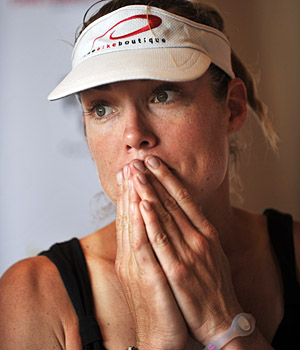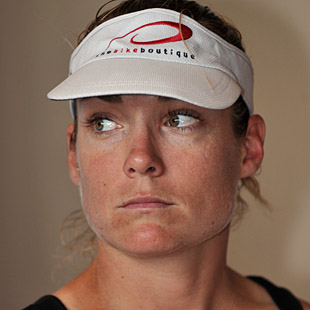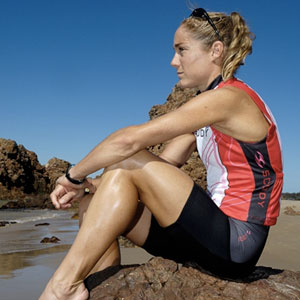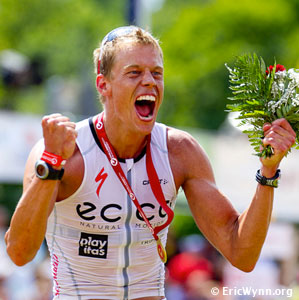Keat vows to break runner-up syndrome

Rebekah Keat has posted the second fastest women's time at the Ironman distance in history. She has also outrun the fastest and arguably greatest Ironman woman in history. And at one magical moment of competitive generosity she lent that very same fastest Ironman woman in history the CO2 canister that rescued Chrissie Wellington from a flat tire and disaster and made possible for the Brit her legendary second Ironman Hawaii victory.
So as Bek Keat is favored to win the inaugural Challenge Copenhagen Ironman-distance event in the Danish capital, she is often asked to comment on the stunning quantum leap in the triathlon evolutionary ladder of Wellington and what it all means.
"It's hard to watch because she's here in our era," says Keat more with a tone of curiosity than any actual jealousy. "If she wasn't around in my era, I'd probably be considered one of the best triathletes in the world. But she always overshadows all of us."
Rebekah Keat, who suffered a stint in purgatory when a tainted supplement formally recognized and forgiven by her Australian Triathlon Federation left her with a two-year ban by the ITU, has had her moments of excellence after returning to the game in 2006. She won Ironman Western Australia. Her 8:39 while finishing second to Wellington at Challenge Roth in 2009 remains the second fastest Iron time ever. Her 2:56 marathon that day topped Wellington's mark. This year, afflicted by tech troubles that cost her nine minutes on her bike, finished second to Wellington again at Roth. Lonely this time instead of losing by eight minutes, she was 30 minutes back of Wellington – deep in the shadows of her unbelievable 8:19.
Like everyone else in planet triathlon, Keat pays homage. "She's amazing," said Keat. "People ask me to compare her to someone else in sport. But really there's no one else in any sport so far ahead of her gender and so close to the very best men. It doesn’t happen in golf. It doesn’t happen anywhere else."
Looking on the bright side, Keat says "In a way it's good because she's pushing our own limits. It's just really hard when you have someone so far in front."

Many are looking for answers why Wellington can do what she does, and one responder on the bulletin board of Team TBB – Wellington's first squad – wrote in, "She's just not scared to hurt." Keat and all of her teammates took note. "She's got that mongrel about her," said Keat, using a term that roughly means a ferocious, pain-disdaining animal as committed to the athletic task as a rabid pit bull. "She races like she in a 5k time trial for the whole 180k of the bike. I still can’t hurt myself that much for 5 hours on the bike and not blow up or waste my run." Keat still remembers how her current coach and Wellington's former coach Brett Sutton described what Wellington looked like on that day when she broke 4:40 on the ride. "He said when she passed him she was frothing at the mouth and grunting – she was hurting."
Keat says what may be inspirational ends up formidably daunting. "When I know I am going to be out there for 9 hours, I find it hard to kill myself in that much pain for so long. I think that is one of the main reasons she can do what she does. She never really bothers to make it look easy."
Keat, who made such a fantastic recovery from her time on the sidelines, says it's hard. "It is tough," said Keat. "If she were not around, 8:39 would have been a great time. But I do not think she is unbeatable. The way triathlon's moving with the men, the way their pack is moving in Hawaii, it's a running race. With the women, everyone says things must be easy. But unlike the men, we're always on our own. The guys work together and at those speeds even if they are a legal 10 meters apart, they get a big advantage and can just sit there. "
The way Keat sees it, Craig Alexander is the best runner and that's why he wins. And that's where Keat sees a vulnerability to the dominant one. "If women as strong as Belinda and I and a Julie Dibens can ride together at a legal 10 meters, it is possible to ride with Chrissie. But then, after Roth, you might have to run a 2:48 marathon. That's the second big step."
Keat, with a 2:56 in her quiver, wonders where she might carve 8 more minutes off her marathon masterpiece, but does not admit impossibility. She sees coach Brett Sutton and his punishing regimen as the key to unlock her own quantum leap. "I think my body thrives on doing a lot of races and putting in a lot of hard miles," said Keat. "I think my body thrives on it. After an Ironman, I can run the next day. I'm just lucky I'm sort of built like a man but I seem to recover like a female. Females generally have less muscle mass and seem to recover quicker. And with Brett, we are always training well above or at threshold, for long periods of time and so the racing seems like the easy part."

So what has Sutton done for you?
"He is still trying to unleash the mongrel," said Keat. "If he does, then Chrissie is beatable."
By you or who else?
"Whether it is me or someone else, I don’t know. We have some amazing girls in our squad. (That now includes Tereza Macel, Erika Csomor, Lisbeth Kristensen, and many more ). And we all know that if we happen to be in the same race in top form at the same time, we can work together and someone might be able to stick it to her."
What is the missing piece? Is Wellington simply a superior physical specimen? Keat can't won't allow herself to succumb to a sense of inevitability. "I think it's a confidence thing. In the beginning of my career, Brett guided me to two ITU junior world championships at the Olympic distance (1996 and 1997). But I wasn't confident in myself. Then I was a little bit lost for the next 8 years. Now, after I went through a lot of hard times, I don’t get scared of the work or the races."
Still, the Wellington Gap remains daunting as she challenges some of the better men in Sutton's squad. "James Cunama (of Team TBB) just won the Alpe d'Huez triathlon. He is a seriously great athlete, I'd say one of the top 15 in the world. But at Roth she passed him on the run (on her way to a 2:48) and smiled. He told me 'I wasn't going to let her get me' and he did get her back."
It is hard to contemplate what that means, says Keat. "James is just so fast and to think he is my benchmark if I want to beat Chrissie is scary. Hopefully, he wasn't having a fantastic day."
So as Copenhagen approaches, Keat is hoping to wipe away the disappointment of a second to Gina Ferguson at Challenge Wanaka, a second to super cyclist turned triathlete Carrie Lester at Ironman Australia and a second to Wellington at Roth.




Start the discussion at slowtwitch.northend.network